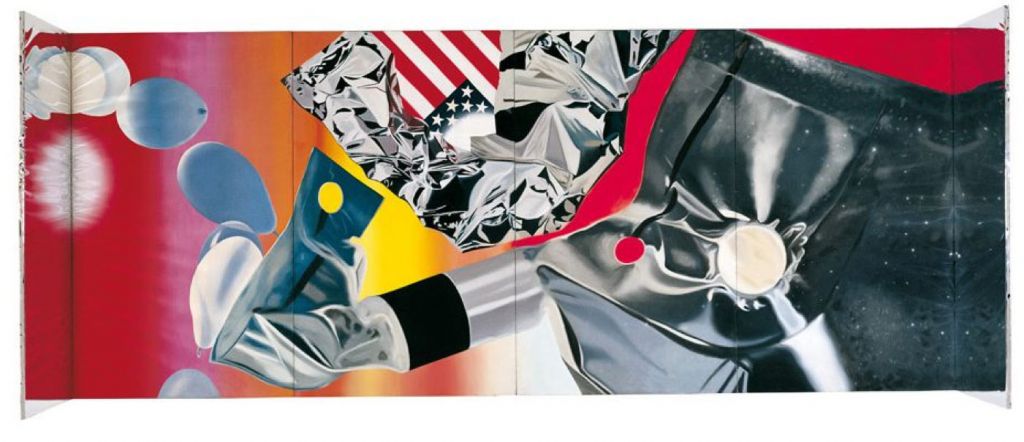
Flamingo Capsule
"When things become peculiar, frustrating and strange, I think it’s a good time to start painting."(1)
James Rosenquist, Flamingo Capsule (Cápsula flamenco), 1970
Oil on canvas and aluminized Mylar, 290 x 701 cm.
Guggenheim Bilbao Museoa
James Rosenquist (b. Grand Forks, North Dakota, 1933) is an American artist whose work over the last four decades has reflected the world in which we live. His works comment on current events, contemporary life, and modern issues, and touch on social, political, economic, and environmental themes. For much of his career, Rosenquist has also expressed in his work a fascination and curiosity about the cosmos, technology, and scientific theory.
As a child, Rosenquist was obsessed with cars and airplanes. His mother used to give him rolls of discarded wallpaper, on which he drew long, continuous narrative scenes and illustrated stories about imaginary battles. (2) He also liked to build model airplanes and even invented his own designs. (3) In 1955, he moved to New York after receiving a one-year scholarship to study at the Art Students League. While in New York, he worked as a billboard painter in Times Square and all around Manhattan, and learned about figurative and commercial painting techniques from fellow workers. By 1960, he had quit painting billboards and rented a small studio in Manhattan. By that time, he was applying the techniques he had learned from painting billboards and commercial advertising to his large-scale artworks. He developed his own style, incorporating the language of advertising to the context of fine art, a practice which would come to be known as Pop art.
Rosenquist’s style developed from fragmenting and recombining images drawn from advertising, using commercial paint, and continuing to work in large scale. He went against the prevailing tide of Abstract Expressionism, creating work that was considered to be more similar to his contemporaries Roy Lichtenstein (b. New York, 1923; d. New York, 1997), Claes Oldenburg (b. Stockholm, 1929), and Andy Warhol (b. Pittsburgh, Pennsylvania, 1928; d. New York, 1987). His popularity rose with his monumental painting F-111 (1964–65). At more than 26 meters in length, this painting critizes the military-industrial complex supporting the United States’ growing consumer culture. It was also considered by many to be an antiwar statement. In March 1967, Rosenquist moved with his family to East Hampton, New York. The size of his new studio there allowed him to paint a number of large canvases, such as Flamingo Capsule (1970). However, even though he was creating large works, Rosenquist was not particularly interested in emphasizing whole objects. Instead, the method he applied to the planning of his paintings, and which he continues to use to the present day, highlights fragments of his subjects.
Flamingo Capsule commemorates three astronauts who died in a flash fire aboard Apollo 1 on January 27, 1967, during a training session. Apollo 1 was part of the U.S. space exploration intiative and was meant to be the first manned lunar landing program. The crew had been training for several hours when a fire broke out inside the capsule. Because of the amount of oxygen inside, the fire spread very quickly. People outside the capsule tried to open the hatch but were not fast enough. Originally named Apollo/Saturn 204, the mission was renamed Apollo 1 in honor of the astronauts Virgil I. Grissom, Roger B. Chaffee, and Edward H. White, who died during the training.
1. James Rosenquist and David Dalton, Painting Below Zero: Notes on a Life in Art (New York: Alfred A Knopf, 2009), p. 195.
2. Rosenquist and Dalton, Painting Below Zero, p. 13.
3. Ibid., p. 14.
Preguntas
Ask students to describe this painting as carefully as possible. What images do they recognize? Which parts are puzzling?
Ask students to connect the painting with the events just described. What can they see that could be related to Apollo 1? Which objects can they associate with the tragedy? Can students locate these images: a crumpled foil uniform emblazoned with the American flag, a twisted and distorted food bag, and the arc of a balloon floating through the air? (1)
In the artist’s description, the composition suggests “fire in a contained space” and “objects floating around in the capsule.” (2) Has the artist managed to show these two concepts? How?
Now that students know the story behind the painting, ask them what their reaction is to this work. Why do students think this incident inspired the artist to create such a poetic image? If they could make it differently, what would they change? Why?
1. “Flamingo Capsule,” The Collection, Guggenheim Museum Bilbao.
2. Ibid.
